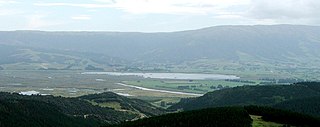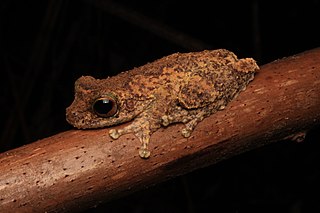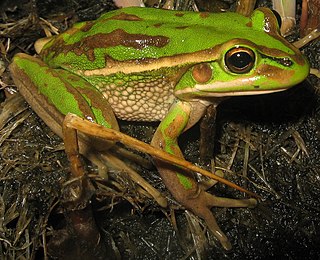
The Sinclair Wetlands are an internationally renowned wetlands located to the south west of Dunedin, New Zealand, at the southern edge of the Taieri Plains. They are on the western side of Lake Waipori and approximately equidistant between Mosgiel and Milton. The protected area covers a little over 315 Ha 3 km2.

The magnificent tree frog, also known as the splendid tree frog, is a species of tree frog first described in 1977. It has a limited range, only occurring on the north-western coast of Australia in the Northern Territory and the Kimberley, Western Australia. It has a similar appearance to, and can be confused with, the closely related White's tree frog.
In biology, a homonym is a name for a taxon that is identical in spelling to another such name, that belongs to a different taxon.

The Blue Mountains tree frog also called the variegated river tree frog is a species of tree frog in the subfamily Pelodryadinae. It is endemic to southeastern Australia and is found in eastern Victoria and in southeastern New South Wales. The Jenolan Caves tree frog, a population formerly separated as Litoria jenolanensis, is nowadays included in this species.

The leaf green tree frog is a species of stream-dwelling frog, native to eastern Australia from the Queensland/New South Wales border south to Sydney.

The striped burrowing frog is a species of burrowing frog in the subfamily Pelodryadinae of the family Hylidae. It occurs throughout much of Australia, from northern New South Wales, through eastern and northern Queensland and into eastern Northern Territory. This species was once included in the genus Litoria or Cyclorana.

The motorbike frog is a ground-dwelling tree frog of the subfamily Pelodryadinae found in Southwest Australia. Its common name is derived from the male frog's mating call, which sounds similar to a motorbike changing up through gears; it is also known as Moore's frog, the western bell frog, western green and golden bell frog, and western green tree frog. The Noongar name for it is Kyooya.Note 1
The Aru tree frog is a species of frog in the subfamily Pelodryadinae. It is endemic to Indonesia. Its natural habitats are subtropical or tropical moist lowland forests and subtropical or tropical swamps. It was originally described on Aru Islands and Misool and may only exist here; it may also exist on Papua although this is not confirmed. It is threatened by habitat destruction by logging and agriculture.
Ranoidea brongersmai is a species of frog in the subfamily Pelodryadinae. It is endemic to New Guinea and known from its type locality in the Snow Mountains, and according to the IUCN Red List of Threatened Species, from another location in the Wapoga River headwaters some 100 km further west. Both sites are in Western New Guinea (Indonesia). Its range is probably broader than current knowledge suggests. The specific name brongersmai honours Leo Brongersma, a Dutch author and zoologist. Accordingly, the common name Brongersma's treefrog has been proposed for it.
The spotted-thighed tree frog is a species of tree frog in the subfamily Pelodryadinae, found in Western Australia.
Ranoidea macki is a species of frog in the subfamily Pelodryadinae, endemic to West Papua, Indonesia. Its natural habitats are subtropical or tropical moist lowland forests, subtropical or tropical moist montane forests, and rivers.

The Treasury Island tree frog is a species of frog in the subfamily Pelodryadinae. It is found in New Guinea and the Solomon Islands. Its natural habitats are subtropical or tropical moist lowland forests, subtropical or tropical moist montane forests, swamps, freshwater marshes, intermittent freshwater marshes, rural gardens, heavily degraded former forests, and canals and ditches. It is threatened by habitat loss.
The Faro Island tree frog, also known as Solomon Islands treefrog, is a species of frog in the subfamily Pelodryadinae. It is found in Papua New Guinea and Solomon Islands. Its natural habitat is subtropical or tropical moist lowland forests. It is threatened by habitat loss.
Eschata is a genus of moths of the family Crambidae.

Ranoidea myola, commonly known as the Kuranda tree frog or Myola tree frog, is a critically endangered species of frog in the subfamily Pelodryadinae. It is endemic to the wet tropics of Australia.

The Ranoidea are a superfamily of frogs in the order Anura. Members of this superfamily are characterised by having the pectoral girdle fused into a single complex unit, having no ribs, and using an axillary grip during amplexus. The larvae have a single spiracle on the left side and complex mouthparts, or in some species, undergo direct development. The taxonomy of these families has been under heavy debate for many years. In recent studies, molecular data has been used to better identify the phylogentic relationships of these frogs, rearranging and introducing new subfamilies to better distinguish between large groups of frogs.

Ranoidea is a genus of frogs in the subfamily Pelodryadinae. They are found in Australia, New Guinea, and two nearby groups of islands: the Maluku Islands, and the Louisiade Archipelago. The circumscription of this taxon is still controversial.
Ranoidea mira, also known as the chocolate frog, is a species of tree frog in the subfamily Pelodryadinae, and is part of the Ranoidea caerulea species complex. It was discovered in New Guinea by a research team led by Griffith University.
Ranoidea callista is a species of tree frog in the subfamily Pelodryadinae, endemic to Papua New Guinea. It has been observed on Mount Trafalgar, about 220 meters above sea level.
Ranoidea fuscula is a species of tree frog in the subfamily Pelodryadinae, endemic to Indonesia. Scientists have observed it in the Derewo River Basin in Papua Province, at 1890 meters above sea level.









